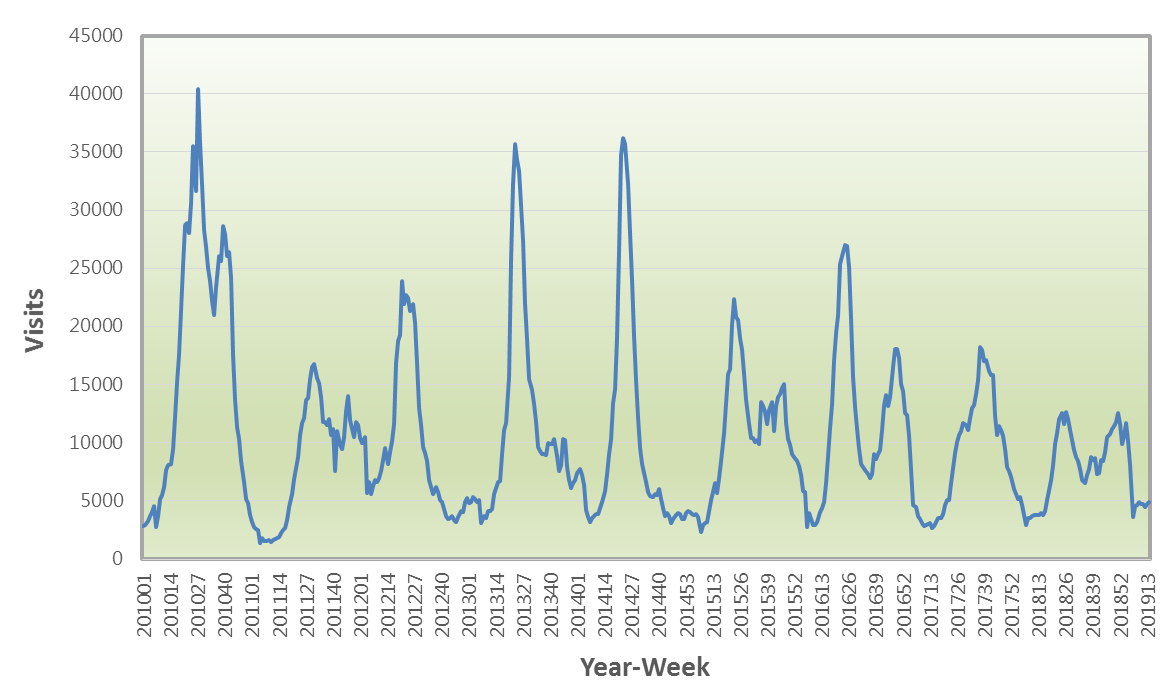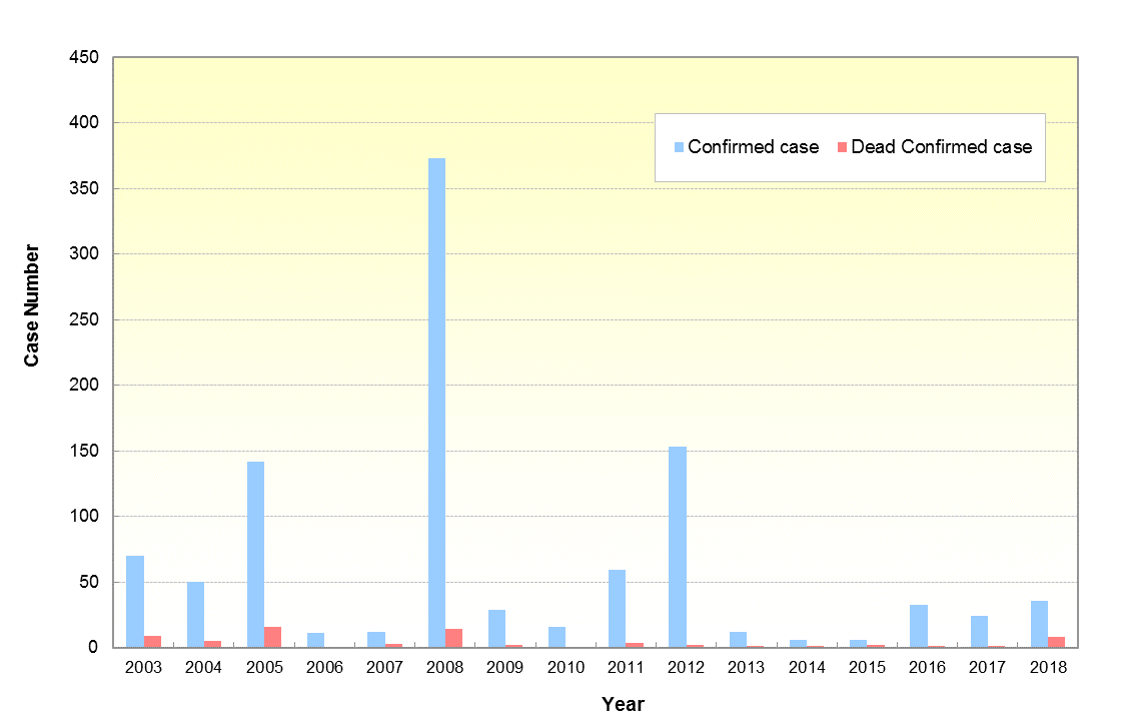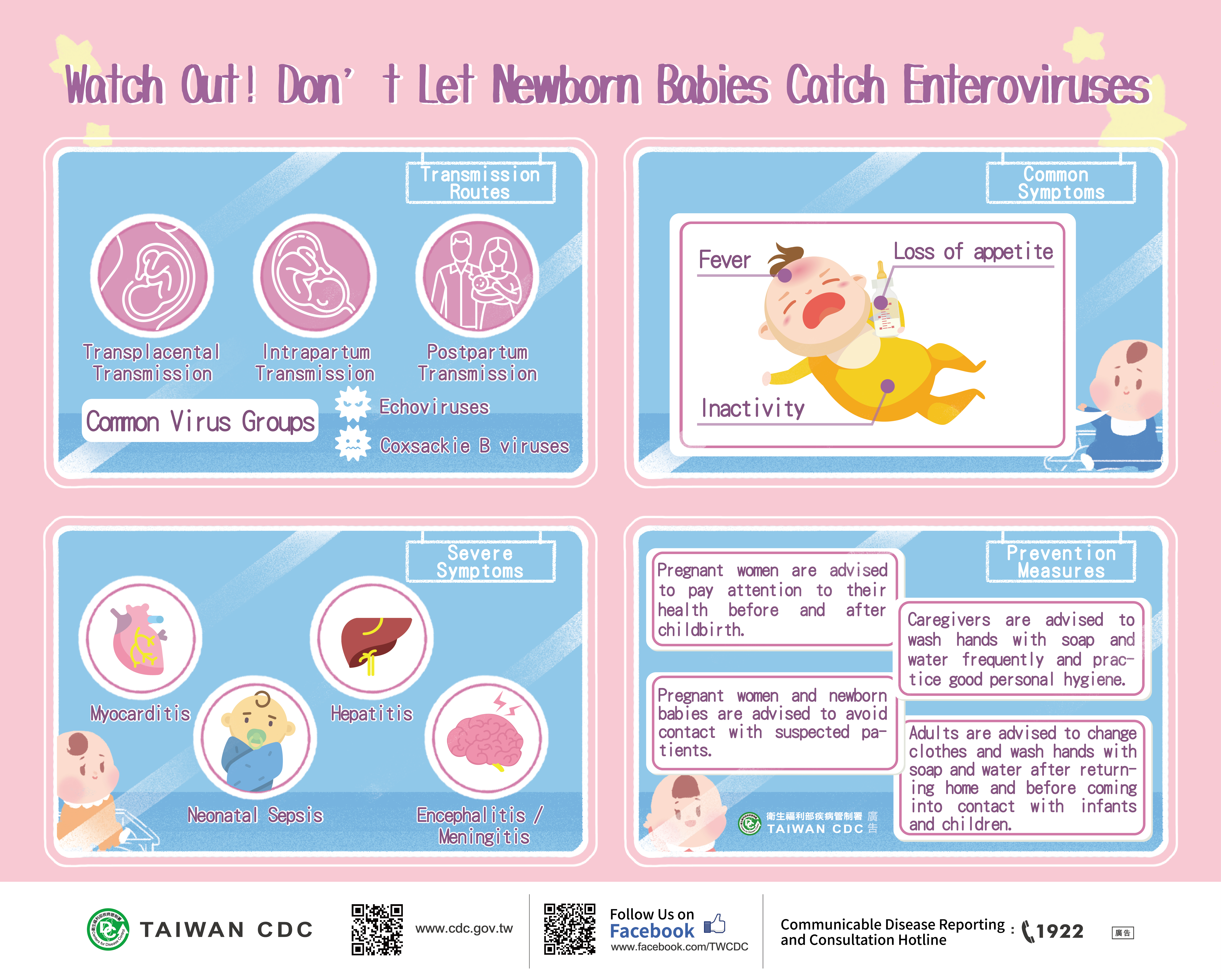Enterovirus / Enterovirus Infection with Severe Complications
Enterovirus belongs to a group of small RNA viruses, including polioviruses, Coxsackie A viruses, Coxsackie B viruses, echoviruses, and other enteroviruses (EVD68~). EVA71 has a significantly higher pathogenicity compared to other known enteroviruses, especially regarding neurological complications. Enteroviruses are found in the gastrointestinal tract (the stool of infected persons, mouth) and respiratory tract (such as saliva, sputum, or nasal mucus). Infections can be caused by direct contact with the secretions of infected persons or with contaminated surfaces or objects. Neonatal infection may also be acquired vertically from an infected mother in utero or at the time of delivery. Humans appear to be the only known host and source for enteroviruses transmission. The patient is contagious before their onset, and the infectivity will last for weeks after the patient is recovered. There are currently no preventive vaccines for non-polio enteroviruses in Taiwan and no known highly efficacious medicine to eliminate the virus once it is inside the human body. Therefore, enteroviruses will continue to pose a threat to human health for the foreseeable future.
Epidemiology
According to survey data gathered over a period of several years by Taiwan CDC and the National Health Insurance (NHI) Administration, the number of weekly outpatient and emergency visits, as shown by the data transferred from the database of NHI, increases in late March and peaks around mid-June. It decreases after mid-June, and then decreases slowly. There is usually another smaller outbreak when schools reopen in September (see Figurev1).
Those survey data also indicate that children under the age of 5 are more prone to critical complications and death. In Taiwan, the case-fatality rate of enterovirus infection with severe complications (EVSC) are ranged from 1.3% to 33.3%. The major symptoms of enterovirus infection are herpangina and hand-foot-and-mouth disease (HFMD). EVA71 is the most commonly seen serotype of cases of EVSC in Taiwan.

Figure1: The number of weekly outpatient and emergency visits for enterovirus infection in Taiwan, 2010-2018

Figure2: Volume of Confirmed Cases and Deaths of EVSC in Taiwan, 1998-2018
EV/EVSC Surveillance in Taiwan?
- Taiwan National Infectious Disease Statistics System–Enterovirus
- Taiwan National Infectious Disease Statistics System–EVSC
- School-Based Surveillance System
Prevention and Control
- Established multiple and real-time surveillance systems for enterovirus infections, covering HFMD and herpangina, severe cases, clustering, virus isolation and typing.
- Constructed a medical service network, including six regional chiefs, 77 responsible hospitals and eight contract laboratories.
- Health Education and Inspection
- (1)Local organizations work with the community to promote enterovirus education and prevention.
- (2)Restaurants, schools, hospitals, clinics and other public gathering places must conduct regular inspections for environmental sanitation and provide hand-washing facilities.
- Establishment of consultation channels staffed by clinical professionals. The professionals provide clinical health care consultation and guidelines for treating enterovirus complications. Primary care for patients with complications can effectively lower the mortality rate.
- “The Manual for Enterovirus Prevention” and “The Handbook for Enterovirus Prevention for Child Care Workers” list all necessary precautions. These materials are provided on the Taiwan CDC website and updated timely.
- Workshops are held on the clinical treatment of critical enterovirus complications to enhance doctors’ skills in treating the disease, raise treatment quality and reduce mortality rates and sequelae.
- To reduce the risk of EVSC clustering, the recommendation of class suspension has been revised for the pre-school education and care institutions, which are high-risk groups.
- Strengthened implementation of infection control measures in hospitals and postpartum nursing care centers to reduce the risk of neonatal enterovirus clusters.
FAQs
- What are enteroviruses?
- Enterovirus is a general term of a group of small RNA viruses which accounts for more than 100 viruses, including Coxsackieviruses A, Coxsackieviruses B, polioviruses, echoviruses, and enteroviruses.
- Are these enteroviruses only found in Taiwan?What are the epidemic seasons?
- These kinds of viruses are usually cause epidemics in summer and early autumn all over the world. Because Taiwan is located in subtropics, the epidemics might take place throughout the year. According to historical statistics, May to June and September to October are the two major epidemic peaks in Taiwan.
- How do enteroviruses spread?
- Enteroviruses can be found on the respiratory secretions (e.g. saliva, sputum and nasal discharge) and stool of an infected person. People may get the infection by direct contact with secretions from an infected person or by indirect contact with contaminated surfaces or subjects. The virus may get into the body through respiratory tract or gastrointestinal tract. Neonatal infection may also be acquired vertically from an infected mother in utero or at the time of delivery.
- Young children are often infected by direct or indirect contacts with adults who may have no symptom but still carry some viruses. They might also be infected by eating foods contaminated by virus-containing excrements. Toys are often the infecting intermediaries between young children, especially the hairy toys which cannot be cleaned routinely and have a higher risk of contaminated by potential pathogens.
- Starting from several days before the appearance of symptom, patients who are infected by enteroviruses may transmit the virus to others and the peak of infectivity occurs within one week of disease onset. The virus can be found both in the throat and the stool. Patient may excrete the virus in the stools for several weeks. Enteroviruses transmitted easily among family members and the infection rate is especially high in crowded areas.
- What symptoms do enteroviruses cause?
- The incubation period of the enteroviruses infection is about 2-10 days. Most of the infected persons have no or very mild symptoms. Most patients will be fully recovered spontaneously with a few days.
- Symptoms of characteristic enterovirus infection include vesicles and ulcers in the oral cavity, vesicles or papules on the palm or sole. Fever is frequently observed. The course of illness is usually 7-10 days. A small proportion of cases may be complicated by aseptic meningitis, encephalitis, myocarditis, pericarditis, pneumonitis and paralysis.
- Under what kind of situations one has to see a doctor immediately?
- If a child with enterovirus infection develops prodromal symptoms of complications such as flaccid paralysis, limb weakness, drowsiness, disturbed consciousness, inactivity, myoclonic jerk (repeated jerky-like movements similar to the startling response that involves abrupt muscle contractions of the whole body), continuous vomiting, tachypnea, and tachycardia, please ensure the child receive medical assistance at a large hospital as soon as possible.
- If a pregnant woman is infected with enterovirus, will she give birth of deformed babies?
- There is no evidence suggesting that enterovirus infection of the pregnant woman may lead to congenital anomaly of the baby. However, the potential risk cannot be totally excluded and pregnant women should avoid being infected as possible.
- Is there any special drug to treat enterovirus infections?
- Currently there is no drugs that can kill enteroviruses. Treatment strategies are mainly to support and stabilize the patient condition, and to relieve discomforts.
- Will one gain the immunity after being infected with the enterovirus?Will he be infected again later on?
- There are more than 100 types of viruses in the group of enteroviruses. One will get a long-lasting immunity once being infected with some enterovirus and the protection against that specific type of enterovirus may last for several decades. One disease entity may be caused by several types of enteroviruses. Therefore, some people may get hand-foot-and-mouth disease or herpangina more than once.
- How high is the mortality rate of enterovirus infections?
- Most patients with enterovirus infection have very mild or no symptoms. Although having not reached a general agreement, the fatality rate of enterovirus 71 infections has been estimated to be between 1/100,000 and 1/10,000 during the first outbreak of enterovirus 71 infection in Taiwan in 1998. In other words, after being infected with enterovirus 71, more than 99.9% of the patients will recover. However, it still caused quite a shock in Taiwan because the mortality rate of enterovirus 71 is higher than other common viral infections. Therefore, it is mandatory to have a thorough understanding of enteroviruses and the routes of their transmission to decrease the risk of infection.
- How to prevent enterovirus infections?
- Currently there is no vaccine to prevent enterovirus infections except for polio viruses. Washing hands often and correctly, adopting good personal sanitation habits are measures to reduce the chances of getting infection.
- (1) Wash your hands with soap and water frequently.
- (2) Clean toys often and do not put them in the mouth.
- (3) Don't go to crowded public areas to avoid infections.
- (4) Go to see doctors as soon as possible while being sick and take days off to get more rests.
- (5) Watch for the cleaning and ventilation of the house.
- (6) Always wash hands before touching children.
- (7) All adults and children should keep sanitation.
- (8) Avoid close contact with people who are sick, especially for the pregnant women, newborns and young children.
- Currently there is no vaccine to prevent enterovirus infections except for polio viruses. Washing hands often and correctly, adopting good personal sanitation habits are measures to reduce the chances of getting infection.
More Information
- WHO|Hand, Foot and Mouth Disease (HFMD)
- USA CDC|Hand, Foot and Mouth Disease (HFMD)
- USA CDC|Non-Polio Enterovirus
Images


